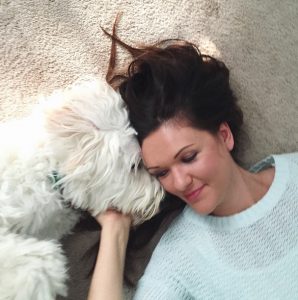From traveling the world to navigating relationships gone wrong, Britteny Winsett’s life was once fueled by coffee, ice cream and boxed wine. But once this lifestyle started to take a toll on her body in 2014, Brit decided to take her health by the horns, making some serious changes to improve her overall quality of life.
Now, she’s a Jane-of-all-trades balancing her health, professional wedding photography business and wellness blog (she even owned a boho boutique at one point—but we’ll leave that for her to share).
Brit has always used writing as a coping mechanism, which is why she started her Celery and the City blog after her body started “falling apart.”
“It’s a great form of therapy,” she says, adding that, at first, she used the blog as a way to spread her newfound passion for health and alternative medicine.
Her posts have evolved into a collection of motivational rantings and revelations related to her favorite topics: nutrition, natural products, travel, life lessons and confessions.
So how does she keep it all up? Mostly, she credits her sanity to her love for Chipotle, her supportive husband and adorable Goldendoodle, Bernie.
We sat down with Brit to learn more about how she manages her gluten-free diet, minor dairy addiction (Cold Stone Creamery is her weakness!), social situations and more.
1. What inspired you to start living a healthy lifestyle?
It was out of necessity for me. I felt like I was dying and I was only 29, yet my yearly checkup kept telling me I was perfect. Like most Americans, I thought I was living right, but was completely uneducated about chemicals, toxins and nutrition.
I finally connected with a holistic doctor who, after reporting on some extensive blood work results, explained what was actually going on inside my body—and it wasn’t so good. He started me on an elimination diet. I saw improvements almost immediately, which led me to understand that it was a dietary factor.
2. So, what’s your diet like now?
On a basic level, I eat whole foods. I am gluten-free (mostly grain-free), dairy-free, soy-free, GMO- and crap-free. This started in 2014 when I was sitting at the Mayo Clinic staring at my endoscopy images showing multiple gastric polyps. Although my celiac test was inconclusive, they told me they were caused by inflammation from gluten. Right then and there, it was gone with the gluten!
As far as dairy, there are two reasons I avoid it. 1.) When your body reacts to gluten, it likely reacts to dairy as the casein proteins are so similar to gluten; 2.) Let’s be real, no one can really digest dairy. As we grow, we no longer produce the lactase necessary to break it down. So even if you don’t “feel” sick after you eat it—it’s probably not making things better.
After cutting it out, I discovered it was a BIG cause of my slow digestion and cystic acne. And there are too many reasons to list why I don’t eat soy or GMOs. (You have the right to know about GMOs, click here to learn more!)
3. What keeps you motivated and who do you look up to?
I am motivated by two things: my desire to get to the bottom of my own issues and the countless people I see just like me who are struggling. Just like I was, there are individuals living off prescriptions, caffeine and chemicals—barely surviving and living in a bubble of misinformation. It’s beyond sad. Every time I get an email from someone who was able to implement a natural alternative in exchange for something toxic in their life—I am inspired.
Although there are so many holistic doctors I follow closely, I have to give a special shout out to Suzanne Somers. I love what she’s doing to educate people on toxins, hormones and holistic health. Her book “TOX-SICK” will change your life.
4. How does Vitacost to support your healthy goals?
I discovered Vitacost when I was required to take lots of supplements in addition to eating gluten-free foods. There were no options in my small town to find wacky things like Ashwagandha powder or gluten-free pancake mix (a necessity, obviously). And the supplements that were available to me locally were so expensive. I had to find a cheaper option—that’s where Vitacost comes in.
5. What does a typical day of eating look like for you?
This changes a lot. I basically stick to whole foods all the time and I eat vegetarian until dinner. If you’ve got low stomach acid like me, too much animal protein will just slow you down and worsen digestion.
I snack every three hours to help with hypoglycemia/adrenal fatigue. So, breakfast might be chia pudding with fruit, nuts, hemp seeds or a smoothie bowl. Lunch might be a veggie stir fry, omelet or a salad. Dinner is always an animal protein with veggies and a starch. People think it’s harder to eat healthy, but in reality it’s much simpler. It’s all about getting back to real food.
6. Do you ever splurge? And if so, what are your cheat foods of choice?
I absolutely never, ever eat gluten. But I’ll compromise on dairy occasionally. I’m Italian, so the struggle is beyond real. I have zero problems downing an entire large gluten-free pizza for a special occasion (it’s totally worth the two days it’ll take my body to recover). But if I really want to feel awful, I’ll top it off with my guiltiest pleasure—a frozen treat from Cold Stone Creamery.
7. What challenges have you faced during your transition?
In the beginning, I was very depressed. I was basically in social isolation for two years because I was avoiding so many foods. It was impossible to eat out or travel. No one understood why I had to make all these changes. I live in a town that isn’t health-friendly, so I had to get used to cooking literally every meal.
This meant no more convenience items or fast food. Thankfully, my husband (who’s incredibly awesome) changed his way of life as well. Now that I’ve adapted, I realize it’s hard to be with a group of people who “don’t get it.” The worst part is feeling like an inconvenience. It’s also bad when they try to accommodate you by trying to make gluten-free foods—but they don’t realize that gluten is in everything, not just noodles.
8. What’s your go-to workout? And on the other hand, how do you relax?
Due to adrenal exhaustion and other things, it’s not advised I strenuously work out. But since I don’t want my muscles to completely forget how to work, I walk, bike and practice yoga.
As far as relaxing goes: massages—all day errrry day!
9. Top three items from Vitacost you can’t live without, GO:
I can’t live without Enzymedica Digest Gold enzymes. These help with any digestive complain. The Vitacost brand extra virgin coconut oil in the huge 54-oz. bottle is the best deal around.
Third, Reviva Labs 10% Glycolic Acid Cream is my best kept skin secret. Glycolic acid is more effective than retinol because it has a smaller molecule size and can actually travel deeper into the skin and doesn’t have the nasty peeling effects of retinol. It’s the cheapest, most effective way to clear acne, get rid of fine lines, fix hyperpigmentation and make you have a new face every morning. I get emails all the time from people raving about it.
10. Word of advice for nutrition newbies?
Watch “Food, Inc.” This documentary exposes what is really going on with our food supply. Another one to watch is “The Human Experiment,” which focuses more on the toxic chemical burden we experience and how it causes disease.
Seek out a holistic or integrative doctor who is focused on figuring out WHY you have health issues, not just pairing your symptoms with a drug. The truth is getting out there, but you have to seek it. You’ve got to understand what’s causing the illness before you can prevent and fix it.

